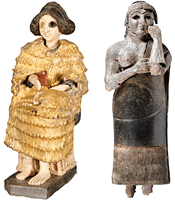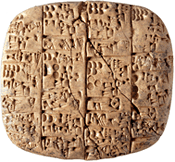Royal Goddesses of a Bronze Age State
by Marco Merola
It's been more than 30 years since Italian archaeologists found a vast archive of 17,000 cuneiform tablets at the Bronze Age site of Ebla in northern Syria. But the ancient city is still surprising those who work there. Last year archaeologist Paolo Matthiae's team discovered two almost perfectly preserved figurines that confirm textual evidence for a royal cult of the dead focused on the city's queens. They also found an unusual tablet that allowed scholars to reconstruct the political climate that led to Ebla's destruction in 2300 B.C., when it was sacked by Sargon of Akkad.
 Its arms arranged in a gesture of prayer, the figurine at right probably depicts a living queen worshipping the statuette of a dead royal, left. (Courtesy Maura Sala)
Its arms arranged in a gesture of prayer, the figurine at right probably depicts a living queen worshipping the statuette of a dead royal, left. (Courtesy Maura Sala)
"We made the finds in two peripheral rooms of the great Royal Palace, where we discovered the cuneiform archive in the 1970s," explains Matthiae. "They were part of the zone behind the Court of the Audience Hall, a sort of storage area which must have held the treasures of the king of Ebla."
Initially the team avoided the rooms, assuming they had been emptied when Sargon ransacked the city. "But we were wrong!" says Matthiae. "Evidently the two statues were crushed into the ground and miraculously escaped the pillage."
Both figurines are intricate representations of women, which are rare in Near Eastern Bronze Age art. One, made of steatite and wood, is depicted with her arms arranged in a gesture indicating prayer. The second figurine holds a goblet and wears an ornate gold dress. Both seem to have been used in a ritual mentioned in a tablet from Ebla that describes how the city's dead queens became female deities who were then worshiped privately by their successors. Matthiae suspects the steatite figure depicts a living queen who would have prayed to the gold-covered figurine, itself a representation of a dead queen who had become a goddess.
 This cuneiform tablet, ca. 2300 B.C., details arms shipments from Ebla to allied states. (Courtesy Maura Sala)
This cuneiform tablet, ca. 2300 B.C., details arms shipments from Ebla to allied states. (Courtesy Maura Sala)
In the same area, Matthiae found a cuneiform tablet which accounted for weapons distributed from Ebla to allied cities during a war sometime before 2300 B.C. "The military campaign the tablet mentions is possibly the one Ebla waged against the state of Mari," says Matthiae. Records indicate that Ebla defeated Mari, its great commercial and political rival, just before it in turn was destroyed.
Matthiae thinks Ebla's military aggression alarmed the powerful states of southern Mesopotamia, such as Akkad, because soon after its conflict with Mari, Sargon launched his campaign against the city.
The tablet lists the number of spear points Ebla sent to each of its allied states, a stark expression of the political influence and military prowess the southern states feared. Nagar, today known as Tell Brak, was the biggest client, receiving 2,000 spear points. According to Matthiae, this proliferation of weaponry may have impelled Sargon to launch the preemptive strike against Ebla, which ended the state.
Source


